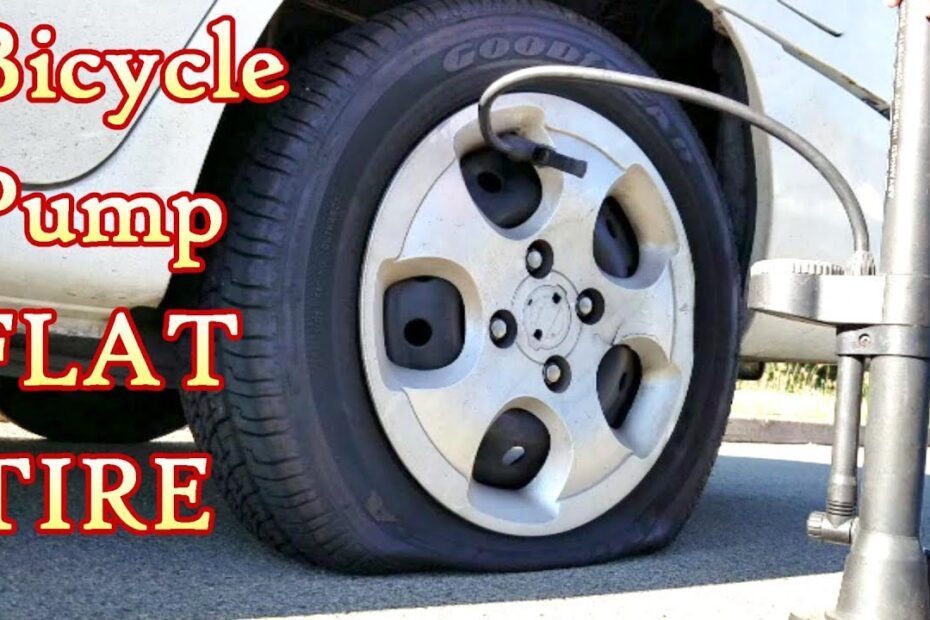Assuming you don’t have a compressor and are using a bike pump, it will take longer to pump up a car tire than it would to pump up a bike tire. It will take about 10 minutes to fully inflate a car tire with a bike pump.
If you’ve ever had a flat tire, you know the feeling of frustration that comes along with it. You’re stuck on the side of the road, and all you can think about is getting back on your way. The last thing you want to do is wait around for a tow truck or AAA.
You just want to get moving again!
One option for fixing a flat is to pump up your car tire with a bike pump. But how long will this take?
It really depends on the size of your tires and the capacity of your bike pump. A standard bicycle pump can inflate a car tire in about 10 minutes. But if you have larger tires or a lower-capacity pump, it could take longer.
The best way to avoid being stranded with a flat tire is to check your tires regularly and keep them inflated to the proper pressure. This way, you’ll be less likely to have a flat in the first place – and if you do, pumping up your car tire with a bike pump won’t be such a big deal!
Pumping Car Tire With Bike Pump Reddit
It’s happened to all of us at one point or another. You’re out on a ride, enjoying the wind in your face and the sun on your back, when suddenly you hear that telltale hissing sound. Your tire is flat.
For most people, this would be a major inconvenience. But for those of us who are prepared, it’s no big deal. We know how to change a tire and we have all the necessary tools with us.
One of those tools is a bike pump.
So, can you use a bike pump to inflate a car tire? The answer is yes!
In fact, it’s quite easy to do. Here’s how:
-Remove the cap from the valve stem on the car tire.
-Attach the bike pump to the valve stem (you may need an adapter).
-Pump away! It will take some time and effort, but eventually the tire will be inflated enough to get you where you need to go.
Just be sure not to overinflate as that could cause problems down the road.
Best Bike Pump for Car Tires
A bike pump is an essential tool for any cyclist, and can be a lifesaver when you get a flat tire while out on a ride. There are many different types of bike pumps on the market, but not all of them are well suited for use with car tires. In this blog post, we’ll take a look at the best bike pumps for car tires, so you can be prepared next time you have a flat.
Pumps come in two basic varieties: floor pumps and hand pumps. Floor pumps are larger and more unwieldy, but they’re also much faster and easier to use. Hand pumps are smaller and more portable, but they take longer to use and can be more difficult to operate.
When choosing a bike pump for car tires, it’s important to consider how often you’ll need to use it, as well as how easy it is to carry with you.
Floor pumps are the best option for those who have flats frequently or who don’t mind carrying around a larger pump. They’re quick and easy to use, making them ideal for those who don’t want to waste time fiddling with a small hand pump.
Can I Use a Car Tire Pump on My Bike
Sure, you can use a car tire pump on your bike, but it’s not going to be as effective as using a dedicated bike pump. Car tire pumps are designed for much larger tires and thus have less pressure per square inch than a bike pump. This means that it’ll take longer to get your bike tire up to the correct pressure using a car tire pump.
Additionally, the nozzle on a car tire pump is usually too large to fit snugly onto a bike valve, so you’ll likely have to hold it in place while pumping, which can be tricky. All in all, it’s not worth the hassle – just get yourself a good quality bike pump and save yourself the headache.
How to Inflate a Car Tire Without a Pump
If you’re stranded on the side of the road with a flat tire and no pump, you may be wondering how you’ll ever get back on the road. While it’s not ideal, it is possible to inflate a car tire without a pump. Here’s what you need to do:
1. Find a can of fix-a-flat or similar product. This will give you the temporary inflation you need to get to a service station.
2. Remove the cap from the valve stem and screw on the nozzle from the fix-a-flat can.
3. Press down on the can to release air into the tire until it is inflated enough to drive on. Be careful not to overinflate, as this could cause further damage to your tire.
4. Drive slowly and carefully to a service station where you can properly inflate your tire with an air compressor or hand pump.
Can You Pump Up a Car Tire With a Foot Pump
A foot pump is a great way to inflate a car tire if you don’t have access to an air compressor. It’s important to know how to use a foot pump properly so that you don’t damage the tire or the pump. Here are some tips:
– Make sure the valve stem is fully open before you start pumping.
– Pump slowly and evenly until the tire is inflated to the desired pressure. Don’t overinflate!
– If the tire gets too hot, stop pumping and let it cool down for a few minutes before continuing.

Credit: www.wikihow.com
-How Long Does It Take to Pump a Car Tire Using a Bike Pump
Assuming you’re talking about a standard bicycle hand pump, it should take about 60-80 strokes to fill a road tire to 80 PSI. A mountain bike tire may take more strokes, as they typically require higher pressure.
Real Time Bike Pump a Flat Car Tire
Conclusion
Assuming you don’t have an air compressor, and are using a bike pump:
It’s best to check your tire pressure when they’re cold, so either first thing in the morning or after they’ve been sitting for a few hours. Use a tire pressure gauge to see what the current reading is, then add or release air accordingly.
If you’re not sure what the ideal pressure should be, it’s usually written on the side of the tire.
For a mountain bike with 26-inch tires, it’ll take about 30 strokes of the pump to add 1 psi (pound per square inch). That number will go up as tire size increases.
For example, it would take 60 strokes to add 1 psi to a 29-inch mountain bike tire.
- Why Ease of Use is Crucial in Trucking Dispatch Software - September 22, 2024
- Better Communication With Dispatchers: How Trucking Dispatch Software Can Optimize Operations - September 7, 2024
- Maximizing Efficiency: The Importance of Accurate Location Tracking for Trucking Operations - August 23, 2024

